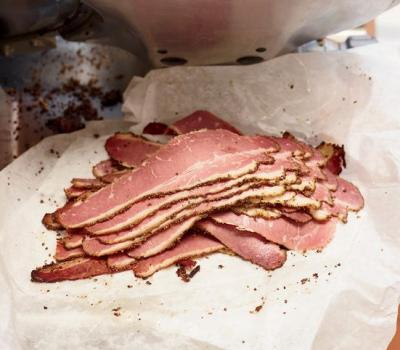All tags
5 star recipes
A
air fry
alcohol beverages
Beverages
BREADS
Breakfast
cakes
Candy
Casseroles
charcuterie boards
Chicken
chili
Chinese
Chowder
Christmas
coffee cakes
Conversion Chart
cookies
dale.
DESSERTS
DIPS
easter
fish
Freezer Meals
Friends
Halloween
herbs/spices
jan's canning
jan's ice cream
meat
Mexican
MISC
Muffins
new years
pasta
Pastry
Pies
polish
Potatoes
potpourri
pressure canner
QUICK BREADS
Rice
Salad Dressings
SALADS
sandwich spreads
Sandwiches
Seafood
Skillet
SNACKS
Soup
st. patrick
Stews
summer
t
Thanksgiving
Vegetables

Smoky Pastrami
Ingredients
4 quarts water8 garlic cloves, crushed
1 1/2 cups kosher salt
3/4 cup granulated sugar
2/3 cup packed light brown sugar
2 tablespoons pink salt or other curing salt (see Note)
1 tablespoon pickling spice
1 teaspoon yellow mustard seeds
1 (7-pound) flat-cut beef brisket, fat layer trimmed to 1/3 inch
About 8 pounds hardwood charcoal
1/4 cup whole black peppercorns
2 tablespoons coriander seeds
6 cups hardwood chips, for smoking
Instructions
DirectionsBring water, garlic, kosher salt, granulated and brown sugars, pink salt, pickling spice, and mustard seeds to a boil in a large stockpot over medium-high heat. Simmer, stirring occasionally, until the salts and sugars have dissolved, about 20 minutes. Pour the brine into a large heatproof bowl and let it cool to room temperature, about 30 minutes. Chill, uncovered, until completely cooled, about 45 minutes.
Using a metal skewer, poke holes all over the brisket. Pour the brine back into the stockpot, or into a large roasting pan. Add the brisket and top with heavy plates to weigh it down and keep it submerged in the brine. Cover the pan with plastic wrap. Refrigerate for 5 days, turning the brisket once a day, using the plates to keep the brisket submerged and covering the brisket in plastic after each turn.
Remove the brisket from the brine and discard the brine. Pat the brisket dry with paper towels. Place the brisket fat side up on a wire rack set inside a large, rimmed baking sheet. Refrigerate, uncovered, for 24 hours.
Place the peppercorns and coriander seeds in a spice grinder; pulse until coarsely ground, about 6 pulses. Rub spices over fat side of brisket, pressing gently to adhere; set aside, uncovered at room temperature. Soak the hardwood chips in water for 30 minutes; drain well.
While the wood chips are soaking, open the bottom vent of the grill completely. Light a charcoal chimney starter filled with charcoal (about 50 pieces). When the charcoal is covered with gray ash, pour them onto the bottom grate of the grill, and arrange them around the perimeter of the grill. In the center of the coals, place a double layer of heavy-duty aluminum foil. Put an 8-inch heavy duty aluminum pie plate on the foil and fill the plate halfway with water (about 1 cup water). Scatter about 1 cup of the drained hardwood chips over hot coals. Coat the grill grate with oil; place on grill. Maintain internal temperature at 200°F to 225°F for 15 to 20 minutes. Place brisket, fat side up, on the oiled grate over the water pan. Smoke, covered, until a thermometer inserted in the center of the brisket (where the point and flat meet)] registers between 160°F to 165°F, about 4 hours. Replenish with additional coals and about 1 cup of the drained hardwood chips if smoker drops below 200°F or about every 45 minutes. Remove the brisket, and set aside, uncovered at room temperature.
Preheat the oven to 275°F and position a rack in the lowest position in the oven. Place the brisket on a wire rack set inside a large roasting pan, add enough water to fill the pan 1 inch. Cover the brisket tightly with aluminum foil and bake it in the preheated oven until fork-tender and a food thermometer inserted registers between 200°F and 205°F, 2 1/2 to 3 hours. Remove the brisket from the oven; let rest, covered, for 30 minutes. Thinly slice. Serve warm or at room temperature.
Make Ahead
The smoked whole pastrami can be refrigerated for up to 2 weeks.
Notes
Curing salts (including pink salt, Prague powder, and Morton Tender Quick) are a mix of salt and sodium nitrite.
Originally appeared: September 2010